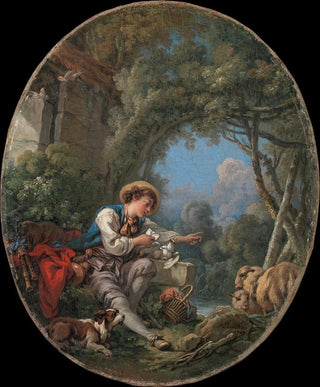Art print | L'envoi du messager - François Boucher


View from behind

Frame (optional)
The Messenger's Dispatch - François Boucher – Captivating Introduction
In the vast panorama of art history, certain works stand out for their ability to capture the essence of an era, evoke deep emotions, and narrate visual stories of rare intensity. "L'envoi du messager" by François Boucher fits perfectly into this category. This piece, emblematic of the 18th century, not only showcases the undeniable talent of its creator but also reflects the spirit of a period where elegance and sensuality took precedence over rigid conventions of the past. In a world undergoing rapid change, Boucher manages to immortalize a moment of communication, exchange, where the messenger, bearing a crucial message, stands at the center of a scene rich in detail and emotion.
Style and uniqueness of the work
François Boucher's style is immediately recognizable, characterized by a rococo approach that celebrates lightness and grace. In "L'envoi du messager," the composition is a true visual ballet, where delicate curves and pastel colors intertwine to create an atmosphere that is both intimate and dynamic. The play of light, subtly orchestrated, highlights the expressive faces of the characters, while the flowing drapery of their clothing adds an almost ethereal dimension to the scene. The presence of the messenger, with his determined expression, contrasts with the softness of the surrounding figures, emphasizing the importance of his mission. Every detail, from the bucolic landscape in the background to the sparks of light dancing on the faces, demonstrates meticulousness and a keen sense of observation that define Boucher's reputation. The artwork thus invites the viewer to immerse themselves in a visual narration where each element contributes to a larger story.
The artist and his influence
François Boucher, born in Paris in 1703, is an essential figure of the 18th century, a period marked by unprecedented artistic flourishing. A student of François Le Moyne, he quickly developed a distinctive style that combined sensuality and lightness. Boucher is not only a painter but also a talented decorator, whose works adorn the salons of aristocrats of his time. His influence extends

Matte finish

View from behind

Frame (optional)
The Messenger's Dispatch - François Boucher – Captivating Introduction
In the vast panorama of art history, certain works stand out for their ability to capture the essence of an era, evoke deep emotions, and narrate visual stories of rare intensity. "L'envoi du messager" by François Boucher fits perfectly into this category. This piece, emblematic of the 18th century, not only showcases the undeniable talent of its creator but also reflects the spirit of a period where elegance and sensuality took precedence over rigid conventions of the past. In a world undergoing rapid change, Boucher manages to immortalize a moment of communication, exchange, where the messenger, bearing a crucial message, stands at the center of a scene rich in detail and emotion.
Style and uniqueness of the work
François Boucher's style is immediately recognizable, characterized by a rococo approach that celebrates lightness and grace. In "L'envoi du messager," the composition is a true visual ballet, where delicate curves and pastel colors intertwine to create an atmosphere that is both intimate and dynamic. The play of light, subtly orchestrated, highlights the expressive faces of the characters, while the flowing drapery of their clothing adds an almost ethereal dimension to the scene. The presence of the messenger, with his determined expression, contrasts with the softness of the surrounding figures, emphasizing the importance of his mission. Every detail, from the bucolic landscape in the background to the sparks of light dancing on the faces, demonstrates meticulousness and a keen sense of observation that define Boucher's reputation. The artwork thus invites the viewer to immerse themselves in a visual narration where each element contributes to a larger story.
The artist and his influence
François Boucher, born in Paris in 1703, is an essential figure of the 18th century, a period marked by unprecedented artistic flourishing. A student of François Le Moyne, he quickly developed a distinctive style that combined sensuality and lightness. Boucher is not only a painter but also a talented decorator, whose works adorn the salons of aristocrats of his time. His influence extends






